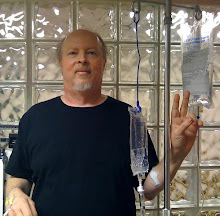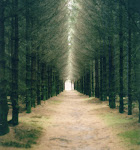We were meeting the Venkats at an Italian restaurant in Sedona early in 2004. Marilyn and I were taking them out as a “thank you” for their website, CLL Topics, and for being there while I stru
 ggled with my diagnosis and early treatment decisions.
ggled with my diagnosis and early treatment decisions.I had run across Topics one night in October 2003, some five weeks after I got the news that I had a virtually unpronounceable as well as incurable disease that could only be treated by dangerous drugs I had never heard of. Topics was a fairly new website then, not quite as encyclopedic or well-known as it is today. But it was still a welcome voice in the wilderness for those seeking to understand chronic lymphocytic leukemia. I found the feedback form and wrote the following:
“Hi, Chaya, et al.: [I didn’t realize the “et al.” was P.C., who acted as webmaster and editor.] I just want to let you know how much I appreciate this website! I have recently been diagnosed with CLL, and your site is a comprehensive, intelligent forum for the latest information. I'm 47 and I feel fine, but have swelling of the spleen and lymph nodes; my oncologist recommends I start chemotherapy within the next couple of weeks. I found your site quite by accident, on page five of a Google search on 'fludarabine.' I'm amazed I had not run across it before. At any rate, thank you so much. I'll be spending a lot of time here in the coming days as I learn everything there is to know about CLL and my treatment options. I see you are in Arizona -- my wife and I live in Sedona. Thanks again for all your hard work. Believe me, it is very much appreciated! Cordially, David”
And I received this reply from a Mr. P.C. Venkat:
“Hi David:
Thanks for your email. Delighted that you find our website a useful resource.
I knew we were going to run into a CLL Topics visitor from Sedona sooner or later. The amazing thing is that until we got your message, it hadn't happened yet. Well, congratulations, you are #1 from Sedona, which is where Chaya and I just happen to live. Welcome, neighbor.
Chaya and I would be happy to hear from you if you would like to talk
 to us. You may reach us at XXX-XXXX. What the heck, we can even meet if that works better.
to us. You may reach us at XXX-XXXX. What the heck, we can even meet if that works better. Best regards,
P. C. Venkat”
That is how our friendship began, and it was the start of our shared struggle against CLL. I say shared, for we were comrades in battle, even though the Venkats had a somewhat better understanding of what we were fighting. Chaya and P.C. quickly became mentors, examples of how to research the facts and put all the information together in a strategic vision.
The struggles of ensuing years were yet to come. That night at the restaurant, over pasta and with our faces framed by candlelight, we were in a sense starting out, optimistic and hopeful.
When Marilyn and I arrived, the Venkats were already there. P.C. looked rather dashing, a thin and wiry man with a salt-and-pepper goatee. Chaya had a friendly face and radiant eyes, and salt-and-pepper hair that complemented his. Before dinner began, P.C. briefly donned a brown Aussie hat to demonstrate how such amazing contraptions are worn.
One thing the Venkats had been learning about was the tendency of CLL patients to develop squamous cell and other skin cancers, of which I had a history. (This is the sort of dinner conversation we often enjoyed with the Venkats: chemotherapy, complications, the latest buzz about promising treatments, as well as the unending kerfluffles in the world of CLL.) Here I was, pink-complexioned, a product of the Russian steppes and the British Isles. And stubborn as hell, having ignored Marilyn’s admonitions for years to wear sunscreen (“too yucky”) and a hat (“too hot,” “too inconvenient”).
Chaya and P.C. put the fear of god in me, with plenty of abstracts sent my way and other incontrovertible evidence that proved that when it came to sun precautions, I was being a dumbass. I will never forget the e-mail P.C. sent me, following on a discussion of skin tone and sun damage:
“Hi David:
Just so that you don't feel singled out on the strength of your undeniable pinkness, consider this. I have cafe-au-lait or perhaps cafe-mocha skin color, I was born in Malaysia (2 degrees north of the E
 quator), and have not always been afflicted with CLL or knowledge of it. Nevertheless, ever since we moved to Arizona, I have worn a broad-brimmed hat, even before I was diagnosed, and wore it on ten yard trips to the mailbox, excursions into the back yard, to the post office, fancy restaurants, doctor's offices, not to mention hikes and long drives. And, I might add, took a lot of ribbing for it from parties I will not mention. With some determination and in spite of an early tendency to lose track of the much maligned object, it has become a trademark. People are surprised now when they see me without the darn thing. See, cussedness does pay off. You can take comfort from this too: if it gets ratty enough, nobody will be tempted to make off with it.
quator), and have not always been afflicted with CLL or knowledge of it. Nevertheless, ever since we moved to Arizona, I have worn a broad-brimmed hat, even before I was diagnosed, and wore it on ten yard trips to the mailbox, excursions into the back yard, to the post office, fancy restaurants, doctor's offices, not to mention hikes and long drives. And, I might add, took a lot of ribbing for it from parties I will not mention. With some determination and in spite of an early tendency to lose track of the much maligned object, it has become a trademark. People are surprised now when they see me without the darn thing. See, cussedness does pay off. You can take comfort from this too: if it gets ratty enough, nobody will be tempted to make off with it.Best,
PC (Mr. Bronze to you.)”
I still smile when I read this even though P.C. is gone, for it sums up his sense of humor, his no-nonsense approach to things, and his willingness to be of help. This was something that ran in both Venkats. A short time later, Chaya published Dying to Get a Tan on CLL Topics. She wrote it with me in mind, she said. In other words, I was the idiot who helped inspire her cautionary warning to patients everywhere. But it was done out of love, and with good humor.
And that is what CLL Topics was and is, a labor of love. It was a labor for the larger patient community, an effort by two people uniquely suited to making sense of insensible papers, a couple with bullshit detectors the size of the Hubble telescope, a talented pair who could separate the wheat from the chaff and distill a muddle of information down to the essential. I was honored to serve on the Topics Board of Directors for a few years and was able to observe close-up the quality of attention that the Venkats put into patient education and advocacy. They lived it and breathed it 24/7.
But Topics was also something more personal, a way for Chaya to help her husband and for both Venkats to put their heads together in search of a way out of this CLL mess. We used to joke about the fact that many of the articles seemed to be about medical issues P.C. was currently experiencing or treatment options that he was considering.
And we also used to joke about the fact that I seemed to be following in P.C.’s footsteps when it came to treatment. We both started out with single-agent Rituxan, for example, and once sat side by side in the infusion room. By last year, when it was clear that P.C. was going to undergo a double cord blood transplant, a transplant looked to be in my future, too. Dr. John Byrd and the inevitable progress of the disease had told me it was.
When we ate dinner last summer at a Thai restaurnt, P.C. explained in detail why the time for his transplant had come. There was no sibling or unrelated donor for an adult stem cell transplant. His remissions from HuMax-CD20 were getting shorter. He
 was in the peak of health, with no comorbidities, and he wasn’t getting any younger. It was clearly a decision that he felt comfortable with, one that made sense.
was in the peak of health, with no comorbidities, and he wasn’t getting any younger. It was clearly a decision that he felt comfortable with, one that made sense.I am reminded here of a quote from the Czech playwright and president Vaclav Havel:
"Hope is not the conviction that something will turn out well, but the certainty that something makes sense, regardless of how it turns out."
And so P.C. began his preparations and earlier this year traveled with Chaya to the University of Minnesota to undergo the procedure. I last spoke to him around the end of May. He was feeling good, happy that the engraftment was going well. It all looked promising. And then, as Chaya has so eloquently explained in Harvey’s Journal, the unexpected happened, and it was followed by the unthinkable: P.C.’s death.
As I write this I still cannot fully believe that he is gone. The story was supposed to end differently, with P.C. finding his cure and me somehow lumbering along after and with the four of us raising glasses of red wine in 20 years and saying, “Remember that time we had CLL?”
Oh, how I wish stories had happy endings. I wish it for Chaya, who wrote article after article with love and affection for the Round-Headed Kid. The EGCG-based recipe for Harvey’s Chocolates symbolized her devotion -– a homemade treat, a way to knock back CLL in the dark chocolate that P.C. enjoyed.
And, of course, I wish it for P.C., who was as good a man as any I have ever known. Many tears have been shed this past week, and not just in Sedona. P.C. had friends everywhere that people struggle with leukemia.
But he would not want us to spend too much time crying; he would call upon us to be brave and continue on. P.C. approached things with logic, focus, and determination. He did not spend his time shaking his fist at the stars or bemoaning his fate. He was not a prisoner of fear. He did not ask anyone else to do the heavy lifting when it came to learning what CLL was and how to cope with it.
P.C. was a superb strategist who did everything right. It was one of those curveballs that Chaya has written about so often that got him. There was no way to see it coming.
It strikes close to home, of course. One of those curveballs may yet get me. Or perhaps I will survive. The one thing I know is that if I do somehow beat CLL, it is because I learned how to fight from P.C. Venkat.
I tip my hat, which I wear all the time now, to you, P.C. You will be missed more than you could ever know.

Three of my favorite people: Terry Hamblin, left, with P.C. Venkat and Chaya Venkat. The photo was taken when the Venkats went to England in 2006. The landscape photos accompanying this post are of Sedona, the sort of scenes P.C. saw every day from the trails he loved to hike with his dog, Jasper.









